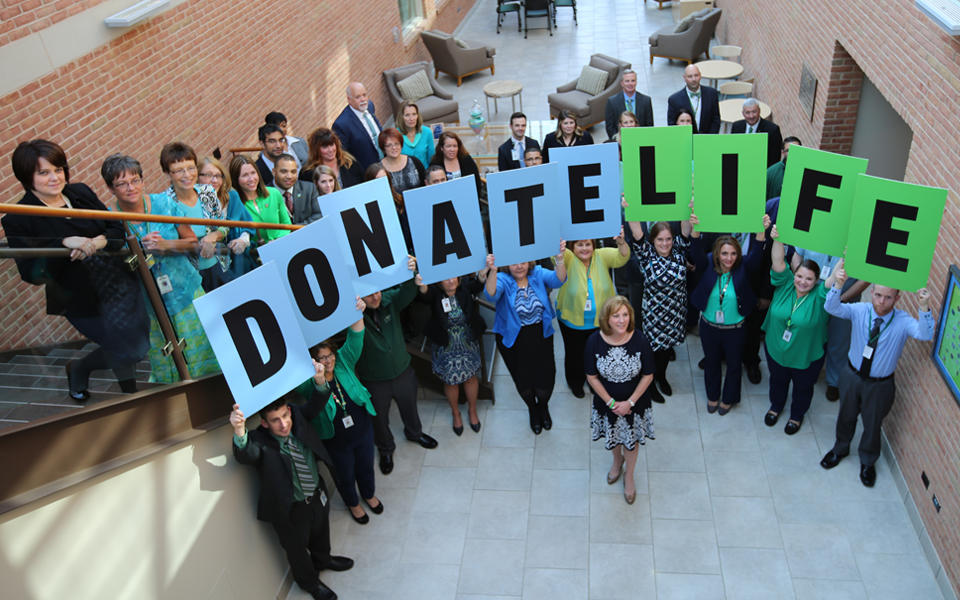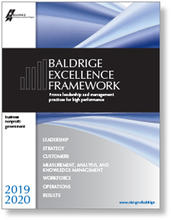Blogrige
The Official Baldrige Blog

CORE staff celebrates National Blue & Green Day at their headquarters in Pittsburgh, PA.
A recent Washington Post article outlined concerns with the nation’s organ recovery and transplant system and a Congressional inquiry that raised “questions about suspected financial fraud and criticiz[ed] the system for its ‘poor performance.’” The concerns have already resulted in new Trump administration performance standards for the nation’s 58 organ procurement organizations (OPOs), which collect organs from deceased donors and send them to transplant centers.
But wait!
There are Baldrige Award-winning OPOs whose performance has proven to be just the opposite—OPOs that are not only saving more and more lives each year (improving their performance) but innovating the industry and sharing best practices.
These are the OPO examples of excellence that I wish were highlighted for Congress:
Center for Organ Recovery & Education (CORE)

2019 Baldrige Award-Winner Center for Organ Recovery & Education (CORE) is federally designated to cover a population of 5.5 million in western Pennsylvania, West Virginia, and one county in New York. With a mission to save and heal lives through donation, CORE has many examples of performance excellence:
- CORE has maintained performance among the top 10% of the nation’s OPOs from 2014 through 2019 for the key industry measure of organ conversion rate, which is the percentage of authorized donations obtained through first-person or next-of-kin authorization.
- For all four of CORE’s key customer groups—donor families, transplant centers, corneal transplant surgeons, and tissue processors—results show satisfaction levels above 90%. The satisfaction rate for donor families has been between 95 and 100%.
- In a best-practice OPO partnership called LINC, CORE has developed algorithms to help normalize results data so that OPOs can better measure and improve their performance through comparison and benchmarking. CORE’s information technology team has also worked closely with the Association of Organ Procurement Organizations to build a tool to examine infrastructure, data, and integration in order to advance OPOs’ best practices.
- CORE is an industry trailblazer for having its laboratory do infectious disease testing and biopsies in-house. For the past five years, CORE has continuously improved its lab biopsy turnaround time (measured in minutes taken to complete biopsy processing).
Donor Alliance

2018 Baldrige Award-Winner Donor Alliance is federally designated to cover 184,151 square miles in the states of Colorado and Wyoming. With a mission to save lives through organ and tissue donation and transplantation, Donor Alliance has many examples of performance excellence:
- Donor Alliance has consistently been ranked as one of the top-10 OPOs in the nation due to its high organ donor conversion rate of more than 80%. (Organ donor conversion rate is the actual number of organ donors divided by the number of patients who are regarded as potential organ donors.)
- The number of organ donors has increased from 109 in 2014 to 144 in 2017, and is projected to reach over 160 in 2018, exceeding the national top-25% comparison for number of organ donors per 10,000 inpatient hospital deaths. Donor Alliance is an industry leader in the number of tissue donors, which has increased from 1,590 in 2014 to 1,752 in 2017 and is in the top 10% nationally.
- All four local transplant center customers reported 100% satisfaction in the 2018 survey. Tissue processors, who are responsible for the preparation, preservation, storage, and distribution of final tissue grafts for transplantation, also reported 100% customer satisfaction.
- Donor Alliance has 200 Advocates for Life: volunteers who work to inspire the public to join the organ and tissue donor registry. Advocates for Life include donor families, recipients, families of recipients, people waiting for a transplant, living donors, and passionate advocates for the cause of donation. They volunteer approximately 3,500 hours and represent Donor Alliance at more than 200 events each year.
Mid-America Transplant

2015 Baldrige Award-Winner Mid-America Transplant is federally designated to cover 84 counties in eastern Missouri, southern Illinois, and northeastern Arkansas. With a mission to save lives through excellence in organ and tissue donation, Mid-America Transplant has many examples of performance excellence:
- To facilitate organ and tissue donations, Mid-America Transplant staff members are in residence at key partner hospitals. This innovation has resulted in a 0.08 percent rate of missed organ referrals since 2012, outperforming the reported best-in-class industry benchmark of 2 percent.
- In 2001, Mid-America Transplant built the nation's first stand-alone organ recovery facility, a system that has significantly reduced the expense of procuring organs compared to the cost of in-hospital organ procurement. Since 2012, the cost-per-donor for in-house cases has decreased from approximately $7,000 to under $4,000, compared to approximately $20,000 when completed in the hospital.
- Mid-America Transplant uses customer data to determine satisfaction with the donation process. Customer complaints per case have been close to zero since 2013 for eye and tissue donations and declined from approximately 7 percent in 2013 to approximately 3 percent in 2015 for organ donations.
- Through its Center for Life, Mid-America Transplant has improved services for donor families by addressing their bereavement needs. Mid-America Transplant also constructed a donor memorial monument and park for donor and recipient families to gather, remember, and honor their loved ones. In addition, an industry-first foundation provides enhanced support to transplant patients and donor families, as well as education on disease prevention for the community.
According to the nonprofit American Transplant Foundation, almost 114,000 people in the United States are currently on the waiting list for a lifesaving organ transplant. Another name is added to the national transplant waiting list every 10 minutes. On average, 20 people die every day from the lack of available organs for transplant.
So, I would share this evidence for hope—there are OPOs striving for high performance to save lives. I’m so proud that the three highlighted above are Baldrige Award winners and national role models.
I hope Congress might consider highlighting them for the learning they could share (and do share at the Baldrige Quest for Excellence® conference). These role models show that excellence and continuous improvement can result in real innovation and improvement to save lives.

Baldrige Excellence Framework
The Baldrige Excellence Framework has empowered organizations to accomplish their missions, improve results, and become more competitive. It includes the Criteria for Performance Excellence, core values and concepts, and guidelines for evaluating your processes and results.
Purchase your copy today!
Available versions: Business/Nonprofit, Education, and Health Care





